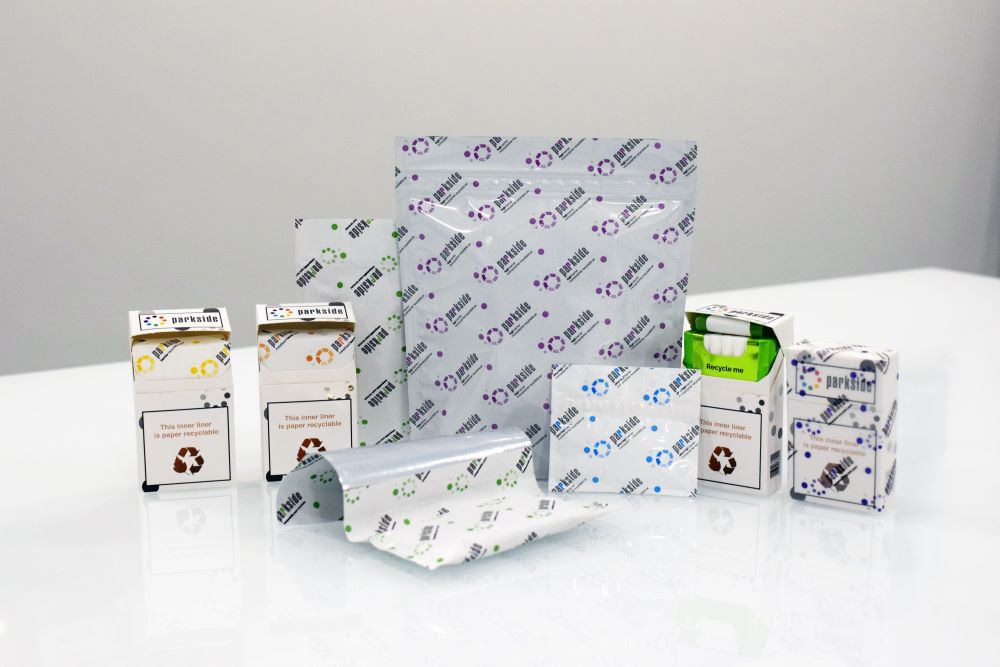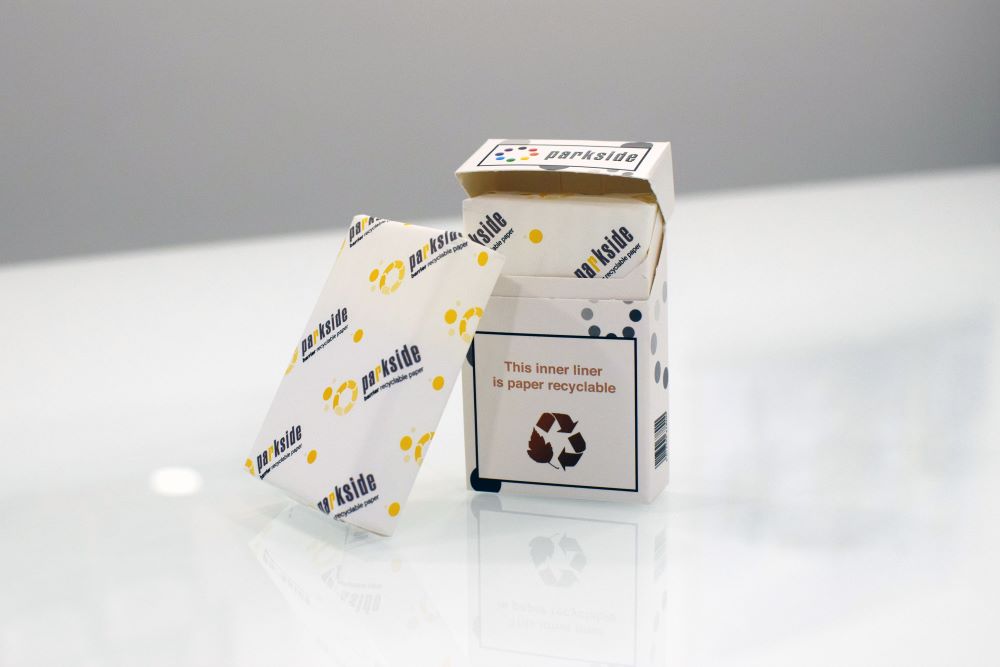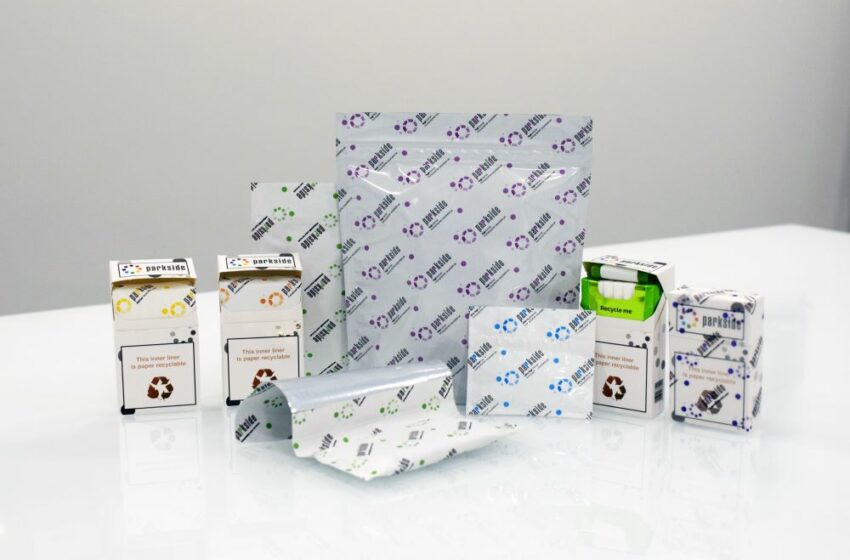
Preparing for Europe’s new waste regulations
By George Gay
In July, Parkside issued a press note describing some of the ways in which flexible packaging might be used to help manufacturers in responding to the EU’s nascent Packaging and Packaging Waste Regulations (PPWR), ideas that Tobacco Reporter followed up on in a conversation with the company’s sales account manager of tobacco, Laura Haggerty.

Tobacco Reporter: Would you please explain to those not entirely familiar with the world of packaging how you define the term “flexible packaging?”
Laura Haggerty: Flexible packaging refers to any item of packaging that is made from a nonrigid material. In the tobacco industry, it’s most commonly seen in the form of loose-tobacco pouches, the shrink-wrap film that we use to protect cigarette cartons, and cigarette carton liners.
However, flexible packaging can be made of almost any material, including plastic, bioplastic, paper and aluminum foil. Each material has its own pros and cons, which is why they are often combined in the form of laminates. A tobacco packaging will often contain several laminate materials to help keep its contents fresh by protecting against moisture and oxygen.
Your press note says a preliminary deal on the PPWR was reached in April. Do you know when the regulations will be finalized?
The provisional text of the deal has been finalized and will come into force at the end of 2024, but some key details will not be decided for several years.
The EU will investigate the viability of bio-based materials in 2027 while the design for recycling guidelines will not be set until 2028. This means PPWR will not take its final form until the end of the decade at the earliest.
When will the regulations be enforced?
While PPWR comes into force at the end of this year, businesses have 18 months to ensure they comply with the new rules. That means, in practice, they will be enforced from mid-2026.
What will be the main differences between the packaging regulations under PPWR and those under the Packaging and Packaging Waste Directive (PPWD) already in force?
The main difference is that PPWR is a regulation whereas PPWD is a directive. In EU law, directives set a goal that is legally binding, but member states have a degree of freedom in how they reach that goal. Regulations are entirely legally binding, setting out policies that member states must follow in full, even if that means rewriting that country’s laws. This will also harmonize regulations across the EU, which should help with implementation.
This is important as it will see extended producer responsibility (EPR) rollout across the EU. EPR is a policy approach that makes packaging producers responsible for the cost of packaging waste management. These costs are meant to encourage producers to design out unnecessary packaging while also incorporating recyclable materials where possible.
PPWR also introduces new, more ambitious targets for waste reduction that each country must meet. These targets are to reduce packaging waste per capita by 5 percent by 2030, 10 percent by 2035 and 15 percent by 2040 compared to 2018 levels. It includes mandatory reuse and refill targets for certain packaging types, more restrictions on single-use plastics and PFAS [perfluorinated and polyfluorinated alkyl substances] chemicals, and new labeling requirements, among many other things.
What are the main ways in which the new regulations will affect the tobacco/nicotine industry?
The introduction of EPR will have a major effect. Tobacco companies operating in the EU will have to cover the costs of waste disposal, so they will find margins squeezed unless they can redesign packaging to be easier to recycle—or use less packaging altogether. When the design for recycling guidelines is finalized, this may become mandatory.
This will affect the use of materials like shrink-film, which is currently problematic to recycle in existing infrastructure, so tobacco companies may have to look at other barrier materials to protect their products through the supply chain.
Part of PPWR also includes new labeling requirements, which tobacco companies will have to incorporate alongside their existing strict labeling obligations.
At this stage, can and should tobacco/nicotine product businesses start considering their options and even taking steps to change at least some of their packaging?
Tobacco companies should absolutely look at ways they can change their packaging. Once PPWR comes into force, they will have around 18 months to ensure all their packaging in the EU market is compliant. This does not leave much time to evaluate, redesign and produce new packaging. Remember that as tobacco packaging is already highly regulated in the EU, any changes must also comply with existing legislation.
Looking at the wider tobacco industry, including its new-generation nicotine products, which of its packaging materials will be affected by the likely changes brought in by the PPWR?
Flexible packaging like pouches will likely be affected as they rely heavily on soft plastics, which are difficult to recycle. As mentioned, this will also affect the shrink-wraps and the inner liners commonly used in flip-top cartons and other rigid packaging, so it will likely have wide-reaching consequences for all tobacco packaging.
Should the industry try to eliminate all “plastic materials” from its packaging, however that term is defined, or should it aim to eliminate only those plastics that do not break down in an environmentally friendly manner and become “forever” particles?
Plastic is often painted as a villain, but the truth is much more nuanced than that. Unnecessary plastic use is a problem, but solving it needs a holistic, considered approach. Simply eliminating all plastics would have a disastrous effect on the environment in the form of increased product waste.
Compostable materials are a possible solution and an area where we are a market leader. We produce accredited compostable pouches that can break down in domestic compost heaps and industrial organic recycling facilities. These materials are commonly used for pouches, but they also have applications as wraps for cigars and liners for cartons.
Which of the Parkside packaging innovations mentioned in your press note would be appropriate for tobacco industry application?
We work closely with our customers in the tobacco sector, so many of our solutions are ideal for tobacco packaging applications. Our Recoflex range includes plastic and paper-based materials that are suitable for recycling and can be tailored with high barrier coatings, metallization and more. We produce pack wraps, individual wraps for cigars, inner liners, resealable lock-and-peel pouches, and compostable pouches, all of which are suited to many applications within tobacco packaging.
Will the arrival of the PPWR regulations provide an opportunity for the tobacco/nicotine industry to make radical changes to its packaging, or do tobacco/nicotine industry-specific regulations make such moves impossible or unlikely?
The strict industry-specific regulations do pose some challenges when it comes to labeling. Packaging will need to contain labeling that describes its material composition and recyclability, so incorporating these new labels in a way that complies with existing restrictions may require some redesigning.
Restrictions on pack shape, such as restrictions on slimline cartons, mean it is difficult to radically rethink many tobacco packaging formats. However, it may be possible to reduce the weight of packs using lighter weight materials combined with water-based barrier coatings to ensure performance.
Presumably, there will be a cost associated with tobacco industry players changing their packaging. How can they minimize such costs while remaining compliant?
We recommend working closely with a trusted packaging partner. At Parkside, we have worked closely with many tobacco companies for many years. That means we have developed the expertise needed to tailor packaging solutions to ensure they meet the needs of our customers in terms of both pack performance and compliance. This ensures packs can be designed and produced efficiently, which is always the best way to minimize costs.
Progressive businesses are generally not opposed to reasonable regulations provided they are evenly applied and competition remains on a level playing field. Do you have any insights, based on your experience with the PPWD, of how strictly and how evenly the new regulations are likely to be applied?
Part of the idea of PPWR is to harmonize regulations across the EU, so that would indicate the intention is to create a level playing field. However, it could still be subject to some variations as different member states have differing infrastructures. A country that already has robust recycling and waste management infrastructure in place will find it much easier to adapt.
As a result, we anticipate PPWR will be applied more evenly than PPWD was—but there may still be some divergence in places.
Finally, while the EU is hugely important to your business, does Parkside focus on other parts of the world?
Certainly. We have invested heavily in our Malaysian site in recent years, meaning we now offer a comprehensive suite of services and solutions to tobacco companies across APAC [Asia-Pacific] countries as well as Europe. This gives us a greater level of agility and flexibility to operate on a global scale.


